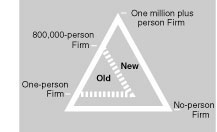FROM PLACES TO SPACES
Technology has always influenced the size of…
companies. The invention of the elevator made possible high-rise buildings, which brought thousands of employees together into one tightly coupled physical space. High-rise towers launched the golden era of the centralized corporation. The advent of telephones on employee desks allowed the centralized corporation to spawn branches in neighboring cities and states, so that corporations grew in staff; at its peak in 1967 GM employed some 850,000 people in all of its factories and administration buildings.
Computers and networking technology initiated a shift in the other direction. What took 8 people before might be done now with 7 using technology. Firms that relied heavily on these technologies could reduce the number of employees. A company like Microsoft today employs a relatively meager 20,000 people.
If firms got smaller with tiny doses of networking technology, then the logical extrapolation dictated that with large doses the firm should continue to reduce until it reached one employee. Some statistics tend to confirm this drift. Counting the 14 million self-employed, the 8.3 million independent contractors, and the 2.6 million temporarily employed in the United States, there are 25 million Americans today working as a unit of one. If this trend continues for a couple more decades, in the future everyone will be a free-agent working for themselves, and our country will be a free-agent nation.

Network technology increases the size of the largest firms yet makes it more possible to have smaller firms while also increasing the number of midsize firms.
But network power cuts both ways. Although networks empower the solo practitioner, they also empower very large organizations. We are just as likely to see the rise of the Godzilla-nation as the free-agent nation. Big has not really been done yet. With the incredible place-shifting power of communication technologies, and a yet-to-be-tapped global market, the world will soon witness corporations that will dwarf the size of the old GM. One can imagine a truly global consultancy, such as Andersen Consultants or Ernst & Young, having a staff of one million worldwide.

